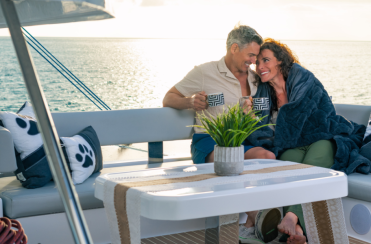You’ve bought your boat. But now you need a boat for your boat. A yacht tender is a vital part of any yacht– it is your ticket to freedom.
Instead of being confined to marinas, a tender provides you the luxury to drop anchor, and still have access to all of the places on land that you would like to go. Avoid crowded marinas, enjoy the ocean breeze, and sleep in peace. Plus, if you are not a catamaran docking master just yet, you can avoid putting on a show for the whole marina to see.
Not only are tenders a thrill to zip around in, they are a practical piece of equipment and something that will be considered during your yacht purchase.
What is a RIB?
Rigid inflatable boats (RIBs) are generally the first choice of cruisers because of the many benefits they offer owners. These are inflatable tenders with rigid hulls, which provide the performance and strength of a solid boat. The hulls are typically made of fiberglass or aluminum, which allow you to cruise through chop, but you’ll probably want to hold on tight. Another added bonus to a RIB is the inflatable tubes on the topsides, which help avoid abrasions to other vessels (and your vessel) when approaching as they provide a fender-like support system.
This type of tender is hard to tip over and can be loaded with many people, toys and provisions. Among all of the other tenders they are very maneuverable and, when in a busy marina, they are easy to pull in, as the inflatable hull will not damage other tenders when bumping your way in. The rigid hull also makes it easier to pull onto a sandy beach. Don’t forget your tender anchor to stop the tender from drifting off when the tide comes in.
Size, bottom material and engine selection
Size and weight are always a trade-off. Sure, you can get that 12 foot dinghy to load up with provisions, but you must also consider that if it is just a party of two pulling up to the beach, you may have a difficult time beaching the boat.
Your choices for the bottom of your RIB are either aluminum or fiberglass. While aluminum is lighter and more durable, a fiberglass hull is quieter and steadier.
Another thing you will consider when choosing your RIB will be the addition of an outboard. Some of the most popular engines on the market are Yamaha, Suzuki, Honda and Mercury. Outboards can range from 3-6 HP, but for those cruisers who have a need for speed (and enjoy being on plane) your best option will be somewhere around 8-15 HP.
Davit vs. platform and weight restrictions
On catamarans there are generally two ways to store your dinghy out of the water. A davit system is one option and, on cruising catamarans these days, electric davits are the industry standard. Another option is the platform, where you lower the platform to the waterline, place your tender on it, and then lift it up. When choosing a tender, the most important thing for you to keep in mind is the weight limitations of your yacht. If purchasing a Leopard Catamaran, the weight restrictions on the davit system is 440 lbs and the weight restriction on the swim platform is 660 lbs. Length is not an issue because both the platform and the davits take the tender out and away from the yacht. Go for the biggest tender that is within the weight restrictions. I always remind my clients to keep in mind that, while comfortable, center console tenders use a lot of the space in the boat, limiting the amount of people that can fit in the tender.
All of the catamarans in the Leopard fleet can be outfitted with the davit system. However, only select models can be outfitted with the platform. The Leopard 50, the Leopard 51 PC and the Leopard 58 can all be ordered with the swim platform option. One things that buyers should take note of when purchasing a dinghy for a swim platform is that the hard body of the dinghy should fit on the chocks of the swim platform. If the dinghy is too small and the inflatable sits on the chocks, the chocks could perforate the inflatable part of the tender.
With all the developments in manufacturing of tenders these days, buyers can find large, lightweight and well-made tenders that fall within the weight limits. This means if you want to go big you can, and you will have a valuable accessory that will enhance the time you spend on your catamaran. I am confident that there is a RIB out there that fits the bill for every cruiser.


